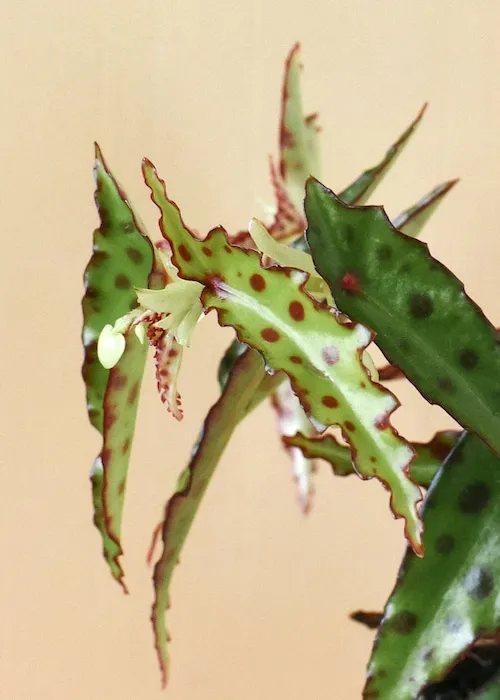Begonia Amphioxus is one of the rare plants you have ever seen, especially its mesmerizing look. The plant is the best choice for enthusiasts of tropical plants and wants to make their garden look unique and attractive. Begonia Amphioxus is a small but eye-catching plant that you can never deny introducing in your garden. The beautiful plant does not bear negligence, so you need to take care of it and provide it with the right growing conditions.
If you decide to grow this plant indoors, do not go anywhere and follow the guide. This guide will provide you with the proper instructions that you can follow to help your beautiful plant grow well.

Begonia Amphioxus is native to Borneo, Indonesia, and is native to tropical regions. New England botanical garden first introduced this plant by Martin seeds. You will love to grow this plant in your household. The plant is bushy and belongs to the Begonia family. The plant’s scientific name originates from ‘amphi’ ‘oxys’, meaning that the plant has pointed ends and they are elongated as well. The nickname of the plant is a butterfly that is due to the crimson marks and the green leaves, and this resembles the butterfly wings.
Just provide the plant with the right growing conditions and let it bloom in a beautiful and mesmerizing way. Let’s look at the requirements of this demanding grower that you need to follow to cultivate the plant at your place.
What is the Scientific classification of Begonia amphioxus?
| Species: | Begonia amphioxus |
| Genus: | Begonia |
| Plant family: | Begoniaceae |
| Origin: | Sabah, Malaysia |
How to do Begonia Amphioxus care?
Humidity preferences:
Do not make a mistake to grow this beautiful Begonia Amphioxus! It depicts that you need to grow this plant in a closed environment and terrariums. The plant highly depends on humidity and cannot tolerate dry environments. The optimum humidity during daytime is 60-80% and from 80-100% in the night time. So, maintain this humidity level and let your plant thrive well.
Pro tip:
Misting is sometimes recommended to maintain the humidity level. So, use a humidifier or mist to let your eye-catching plant grow happily.
Fertilizer preferences:
It is a relatively hungry plant in fertilizers, so you must provide it with suitable fertilizers when required. This does not mean that you need to fertilize your plant regularly.
The right time to fertilize the plant is once a week and use a diluted fertilizer. Reduce the fertilizing requirements in winter to once a month. It will contribute to the fast growth of the plant.
Light preferences:
The plant has some complicated requirements in the case of light that you need to consider. Begonia Amphioxus loves to grow in bright and indirect light. Sometimes it also needs partial sun as it will help provide the plant with the terrarium climatic conditions.
If you are living in a tropical climate, then you need to use fluorescent lights. These lights will help in meeting the growth conditions. Place your plant 8 to 12 inches away from the light to protect the burning of the leaves.
Also, the direct sun can damage the leaves of the plant and can leave wilt and death.
Pro tip:
Place your Begonia Amphioxus on the north-facing window till it starts flowering. After that, find out a brighter place, as this will make the leaves and flowers relatively attractive.
Also check: Begonia Maculata Plant Care | Propagation ( Complete Guide)
Soil preferences:
Begonia Amphioxus grows well in a well-draining, and rich soil, and negligence in this can impact the growth of the plant. The right mixture to prepare the plant’s potting mix includes high-quality peat mix or any ordinary household mix. You can use eggshells, oyster shells, or limestone chips.
Using this mixture will make perfect potting soil for your plant. The rationale for choosing this potting mix is that it will reduce the acidity of the soil. Also, less acidic soil will result in perfect bright red color.
Make sure that you make your soil less acidic and keep it within the range of 6.1 to 7.5.
Pro tip:
If you want to let this plant grow fast, then choose a terrarium. Choosing a terrarium will contribute to the fast growth of your Begonia Amphioxus. Also, choose a spot having a fair amount of light.
Temperature preferences:
Begonia Amphioxus perfectly grows in a closed environment because it helps in maintaining balanced growing conditions. The plant needs high and constant temperature. Otherwise, it will become unhappy.
So, the plant loves to grow in warmth, and the perfect temperature is about 85 degrees Fahrenheit. Place the plant in a closed environment and let your plant flourish.
Pro tip:
Do not let your plant grow at temperatures lower than 50 degrees Fahrenheit, as they are frost-sensitive and can result in the death of your plant.
Watering preferences:
Begonia Amphioxus needs more water as compared to the typical household plants. You need to water your plant three times a week in summers and reduce this to one time in winters. Let the soil of your plant dry before watering it next time. It will prevent root rot and waterlogging; also, your soil will become fast-draining.
Make sure that you must not overwater your plant because it can result in causing root rot and will become more susceptible to the fungal attack.
Pro tip:
One thing that you need to consider is to choose the aquarium or the distilled water. Hard water will not be suitable for the health of your plant. Also, maintain the temperature of the water as Begonia Amphioxus cannot bear this.
You May Also Like: Best Alocasia Lauterbachiana Care Guide | Propagation

Begonia Amphioxus Propagation
Propagation is the easiest and the rarest thing present in this Begonia Amphioxus. You can quickly propagate this plant by leaf cuttings, herbaceous, or seeds. All these three methods will help you propagate your plant in spring.
Propagation by seeds is relatively easy, and you have to place the seeds in the soil and let them grow. Also, you need to maintain the right growing conditions along with the right moisture conditions.
Propagation by stem cuttings
The perfect season to propagate the plant is in spring or early summer. Here’s a list of steps that you need to follow to help your Begonia Amphioxus propagate:
- The first step to propagate is to choose a healthy stem of two inches.
- After that, remove the leaves at the bottom of the stem.
- The next step is to place the stem cutting in a pot or a rooting hormone. It will help in promoting the propagation rate.
- Place the cuttings three inches deep and use moss or perlite in the soil.
- After preparing the potting mix, place your plant in a humid and warm location with higher sunlight.
- You can choose a terrarium or humidity dome to maintain an ideal growing environment.
- Water the plant the right way and prevent it from overwatering.
- You need to check the root development after every three to four weeks.
- Congratulations, here’s your cloned baby Begonia Amphioxus.
Potting preferences:
Maintenance is also required to help your plant grow fast. Potting needs to be done once a year, and you need to check the plant before repotting.
Pro tip:
Do not repot if not required by the plant, as it does not bear pot changes all of a sudden.
Growth:
This plant shows a standard growth rate rather than showing fast or slow growth. Cultivate the plant in the right growing conditions and see the growth of the leaves.
They flower three times a year, and dry conditions can cause the rotting of the leaves.
What are the common problems faced by Begonia Amphioxus?
You might face specific issues with the plant’s health due to mismanagement and poor growing conditions. Following are some of the common issues faced by the plant:
Powdery mildews:
It is one of the standard issues faced by the Begonia Amphioxus and results in causing leaves curling and white patches. The commonly occurring issue is due to the reason that mildews grow in a warm environment. The issue is fatal for the plant and can cause the death of your beautiful Begonia Amphioxus. You need to examine your plant regularly to deal with the issue (if any).
Solution:
You can deal with this issue by washing the plant’s leaves with one tablespoon of baking soda, one gallon of water, and a non-detergent soap. It will result in controlling the growth of powdery mildews.
Begonia Amphioxus Dropping Leaves:
The dropping of the leaves is one of the common issues faced by the plant. This occurs due to the sudden changes in the environment, especially the temperature and the humidity levels. It is not a serious issue, and you can control it by maintaining the growth conditions.
Solution:
Maintain the optimum temperature and humidity requirements to regain the health of the leaves.
Begonia Amphioxus yellow leaves:
The main reason for the yellowing of Begonia Amphioxus is due to overwatering. Overwatering can cause the soil to become soggy, letting the Begonia Amphioxus silt in the water.
Solution:
You can control this issue by maintaining water requirements and do not let your soil stay watery for long.
Final thoughts:
Begonia Amphioxus is a rare and beautiful plant that you will love growing in your households. This eye-catching plant will never disappoint you and will be a perfect choice of yours. But this is not an easy-to-handle plant, and you need to provide it with the right growing conditions.
It is a susceptible plant, especially to environmental fluctuations. Keep your plant happy by providing it with the right growing conditions.
Also, it is prone to fungal infections, and hence you need to examine the plant regularly. Happy growing!
Frequently Asked Questions about Begonia Amphioxus
Which soil suits the best for Begonia amphioxus?
The suitable soil to let your plants grow in rich and well-draining soil. Also, make the right potting mix by adding limestone or eggshells it. It will be a perfect choice of yours.
What are the light requirements of Begonia amphioxus?
These plants love to grow in bright and indirect light. Other than this, direct morning sun for one or two hours is also required. It is sensitive to direct light, so you need to be ver67y careful about these conditions.
Why are Begonia amphioxus leaves turning yellow?
The main reason for the yellowing of Begonia Amphioxus is due to overwatering. Overwatering can cause the soil to become soggy, letting the Begonia Amphioxus silt in the water. So, you need to provide it with optimum watering conditions.
